Crime Prevention Effect of the Second Generation Crime Prevention through Environmental Design Project in South Korea: An Analysis
Abstract
:1. Introduction
1.1. Research Background
1.2. Research Objective
2. Literature Review
2.1. Second Generation CPTED
2.2. Crime Prevention Effect Analysis
3. Methods and Materials
3.1. Methods
3.1.1. Analysis Area
3.1.2. Formulas for Measuring Changes in Crime
3.2. Crime Location Data
4. Results
5. Discussion
6. Conclusions
Author Contributions
Funding
Acknowledgments
Conflicts of Interest
Appendix A
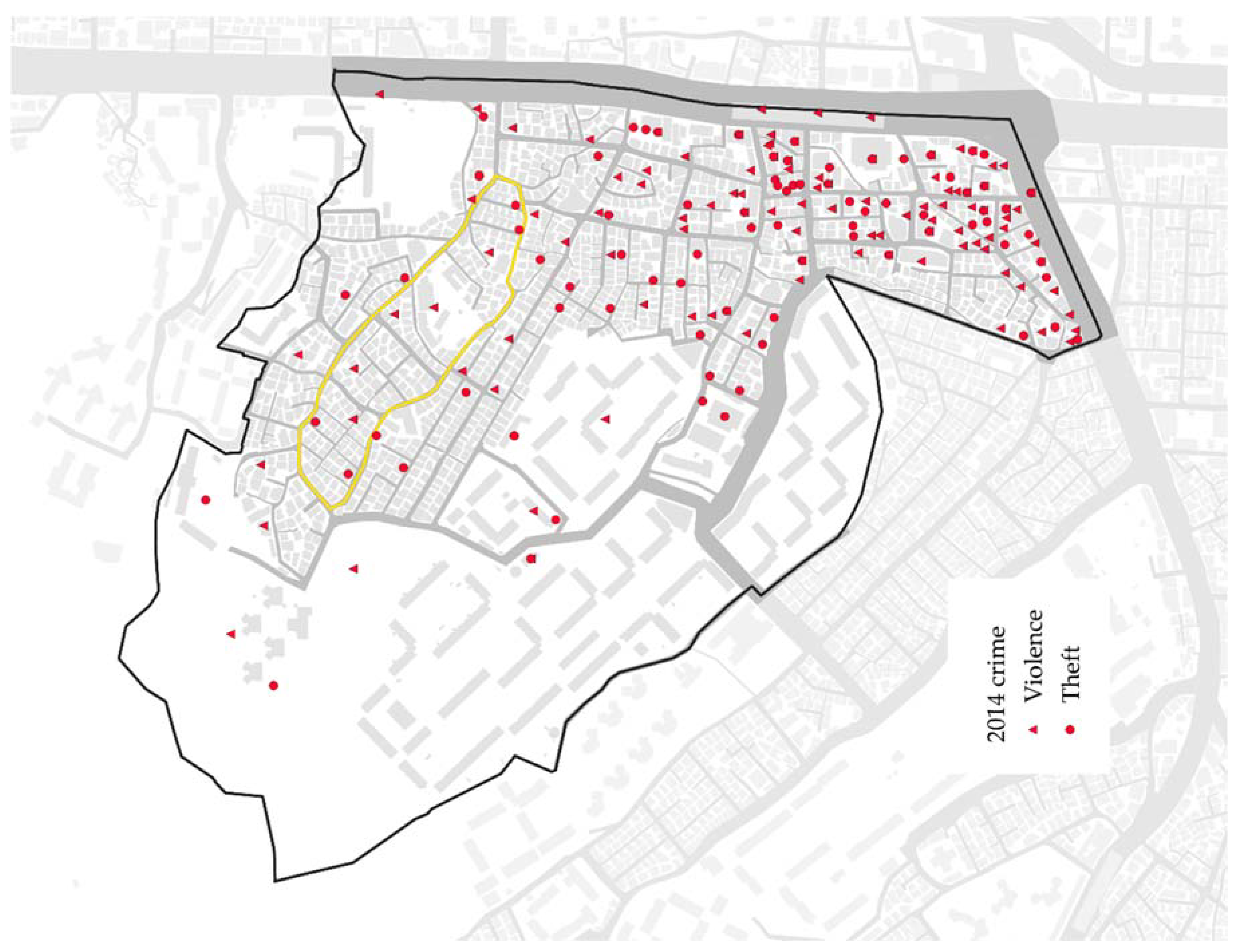
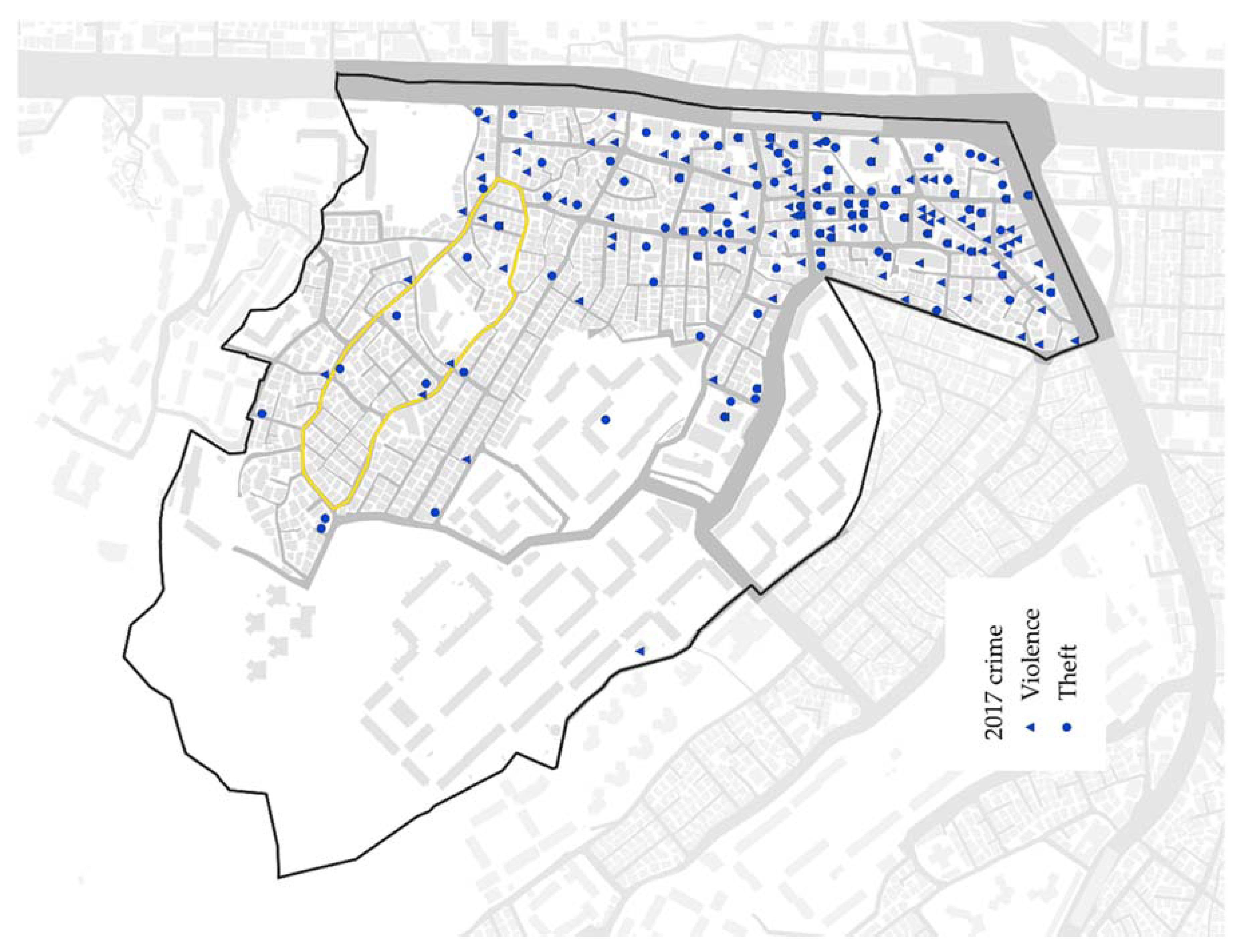
References
- Bichler, Gisela, Karin Schmerler, and Janet Enriquez. 2013. Management Curbing Nuisance Motels: An Evaluation of Police as Place Regulators. Policing: An International Journal of Police Strategies & Management 36: 437–62. [Google Scholar]
- Bowers, Kate J., and Shane D. Johnson. 2003. Measuring the Geographical Displacement and Diffusion of Benefit Effects of Crime Prevention Activity. Journal of Quantitative Criminology 19: 275–301. [Google Scholar] [CrossRef]
- Braga, Anthony A., and Brenda J. Bond. 2008. Policing crime and disorder hot spots: A randomized controlled trial. Criminology 46: 577–607. [Google Scholar] [CrossRef]
- Cha, Yoonmi, and Heesun Jung. 2014. Fear of Crime and Landscape Design in a Deteriorated Residential Area -The Case of Yeomni-dong, Seoul-. The Geographical Journal of Korea 49: 51–71. [Google Scholar]
- Cho, Youngjin, and Yonggook Kim. 2016. Study on Crime Prevention Design Performance for Built Environment -Focusing on Development of Crime Prevention Evaluation Criteria for a Flat of Multiple Dwelling House-. Sejong-si: Architecture & Urban Research Institute. [Google Scholar]
- Cho, Youngjin, and Dongphil Son. 2016. A Study on Amendment of 「Building Act」 and Subordinate Legislation for CPTED. Sejong-si: Architecture & Urban Research Institute. [Google Scholar]
- Clarke, Ronald, and John Eck. 2016. Crime Analysis for Problem Solvers in 60 Small Steps. Washington, DC: COPS. [Google Scholar]
- Cleveland, Gerard, and Gregory Saville. 2003. An Introduction to second Generation CPTED: Part 1. CPTED Perspectives 6: 4–8. [Google Scholar]
- DeKeseredy, Walter S., Alvi Shahid, Claire M. Renzetti, and Martin D. Schwartz. 2005. Reducing private violence against women in public housing: Can second generation CPTED make a difference? The CPTED Journal 3: 27. [Google Scholar]
- Eck, John E. 2004. Assessing Responses to Problems: An Introductory Guide for Police Problem-Solvers; Washington, DC: US Department of Justice, Office of Community Oriented Policing Services.
- Gilligan, James. 2001. Preventing Violence. New York: Thames & Hudson. [Google Scholar]
- Guerette, Rob T. 2007. Immigration Policy, Border Security, and Migrant Deaths: An Impact Evaluation of Life-Saving Efforts under the Border Safety Initiative. Criminology & Public Policy 6: 245–66. [Google Scholar]
- Guerette, Rob T. 2009. Analyzing Crime Displacement and Diffusion; Washington, DC: US Department of Justice, Office of Community Oriented Policing Services.
- Guerette, Rob T., and Kate J. Bowers. 2009. Assessing the Extent of Crime Displacement and Diffusion of Benefits: A Review of Situational Crime Prevention Evaluations. Criminology 47: 1331–68. [Google Scholar] [CrossRef]
- Ha, Mikyoung, Jinhyuk Choi, Dowoo Kim, Roseop Park, Kyunghoon Lee, Youmi Lee, Seokjin Kang, Gibeom Bae, Jibum Jeong, Eunhee Kim, and et al. 2015. CPTED Principles and Operation Management. Seoul: Korea CPTED Association. [Google Scholar]
- Hamilton-Smith, Niall. 2002. Anticipated Consequences: Developing a Strategy for the Targeted Measurement of Displacement and Diffusion of Benefits. Crime Prevention Studies 14: 11–52. [Google Scholar]
- Heo, Boyoung, and Sosoon Park. 2016. The Analysis of the Effectiveness of Safety Community Projects Utilizing the Qualitative Analysis Method and the System Proposal. Journal of the Korean Society of Hazard Mitigation 16: 215–22. [Google Scholar] [CrossRef]
- Hong, Seokju, and Hyaejin Bin. 2017. A Study on the Correlation between the Wall Removal and Crime Prevention through Environmental Design Considering Improvement of Residential Environment. Journal of Korean Living Environment System 24: 858–64. [Google Scholar] [CrossRef]
- Jansson, Krista. 2007. British Crime Survey-Measuring Crime for 25 Years. London: Home Office. [Google Scholar]
- Jeffery, Clarence Ray. 1971. Crime Prevention through Environmental Design. Beverley Hill: Sage. [Google Scholar]
- Jeong, Dasom. 2018. A Study on Effective Crime Safety Village Project. Seoul: Graduate School of Yonsei University. [Google Scholar]
- Jeong, Yongwook, Yonngil Kang, and Myungsik Lee. 2017. Effectiveness of a Project Applying Crime Prevention through Environmental Design in an Urban Area in South Korea. Journal of Asian Architecture and Building Engineering 16: 543–49. [Google Scholar] [CrossRef]
- Jung, Ahreum, and Seokhyun Lee. 2017. The Influence of Residential Crime Prevention through Community Activity. Archives of Design Research 30: 175–87. [Google Scholar] [CrossRef]
- Kim, Sangwoon. 2012. Comparative Analysis of Domestic CPTED Research. The Korean Association of Police Science Review 37: 71–95. [Google Scholar]
- Kim, Kwiryun, Seungin Kim, and Jounghae Bang. 2014. A Study on Expanding and Application of Service Design Evaluation System (SDES) -Mainly with Case Study on Crime Prevention through Environmental Design Project of Seoul City, Saltway-. Journal of Digital Design 14: 155–64. [Google Scholar]
- Kim, Dahee, Seunghui Lee, and Yongwook Jeong. 2018. An Analysis of Crime Prevention Effect of CPTED Elements in Yeomni-dong Using Crime Location Data: Based on Street Segment Analysis Unit. Residential Environment Institute of Korea 16: 13–27. [Google Scholar] [CrossRef]
- Lee, Geon. 2007. (Special Article) Methodological Issues in Surveys of Residents’ Reactions to Aircraft Noise. Journal of Korean Society of Environmental Engineers 29: 144–52. [Google Scholar]
- Maguire, Mike. 2012. Criminal statistics and the construction of crime. The Oxford Handbook of Criminology 5: 206–44. [Google Scholar]
- Maguire, Mike. 2007. Crime data and statistics. The Oxford Handbook of Criminology 4: 241–301. [Google Scholar]
- Moser, Caroline ON. 2006. Reducing Urban Violence in Developing Countries. Washington, DC: Brookings Institution. [Google Scholar]
- Newman, Oscar. 1972. Defensible Space. New York: Macmillan. [Google Scholar]
- Park, Youngju, and Woosuk Yoon. 2014. Analyzing the Effects of CPTED on Females’ Risk of Victimization and Fear of Crime: Focusing on Female Residents in Daegu City. Korean Association of Public Safety and Criminal Justice 23: 80–109. [Google Scholar]
- Park, Hyeonho, Youngsun Hwang, and Dongkeun Kim. 2011. A Study on the Crime Displacement Effect of CCTV by WDQ Analysis. Korean Police Studies Association 10: 107–28. [Google Scholar]
- Park, Kyounglae, Insub Choi, Eunyoung Kang, Seonghun Park, Yonggil Kang, and Sangmi Kim. 2013. Preliminary Analysis of Effectivess of Seoul City CPTED Project. Seoul: Korean Institute of Criminology. [Google Scholar]
- Piza, Eric L., Joel M. Caplan, Leslie W. Kennedy, and Andrew M. Gilchrist. 2015. The Effects of Merging Proactive CCTV Monitoring with Directed Police Patrol: A Randomized Controlled Trial. Journal of Experimental Criminology 11: 43–69. [Google Scholar] [CrossRef]
- Piza, Eric L., Andrew M. Gilchrist, Joel M. Caplan, Leslie W. Kennedy, and Brian A. O’Hara. 2016. The Financial Implications of Merging Proactive CCTV Monitoring and Directed Police Patrol: A cost–benefit analysis. Journal of Experimental Criminology 12: 403–29. [Google Scholar] [CrossRef]
- Ratcliffe, Jerry H., Travis Taniguchi, Elizabeth R. Groff, and Jennifer D. Wood. 2011. The Philadelphia Foot Patrol Experiment: A Randomized Controlled Trial of Police Patrol Effectiveness in Violent Crime Hotspots. Criminology 49: 795–831. [Google Scholar] [CrossRef]
- Sampson, Robert J., Stephen W. Raudenbush, and Felton Earls. 1997. Neighborhoods and Violent Crime: A Multilevel Study of Collective Efficacy. Science 277: 918–24. [Google Scholar] [CrossRef] [PubMed]
- Saville, Greg, and Gerry Cleveland. 1997. second Generation CPTED: An Antidote to the Social Y2K Virus of Urban Design. Paper presented at Second Annual International CPTED Conference, Orlando, FL, USA, May 3–5. [Google Scholar]
- Saville, Greg, and Gerry Cleveland. 2003. An Introduction to second Generation CPTED: Part 2. CPTED Perspectives 6: 7–9. [Google Scholar]
- Saville, Greg, and Gerry Cleveland. 2008. Second-generation CPTED: The Rise and Fall of Opportunity Theory. In 21st Century Security and CPTED. Fort Lauderdale: Auebach Publications, pp. 93–104. [Google Scholar]
- Seo, Yoonkyung. 2015. (Thesis): The Representations of Crime Prevention Design Projects Initiated by the City of Seoul—With a Focus on Analysis of Images of Yeomni-ding Salt Way. Studies in Urban Humanities 7: 73–106. [Google Scholar]
- Seoul. 2014. Seoul City Dongjak-gu CPTED Ordinances; Seoul: Seoul Metropolitan Government.
- Shaw, Margaret. 2001. The Role of Local Government in Community Safety (No. 2); Washington, DC: US Department of Justice, Office of Justice Programs, Bureau of Justice Assistance.
- Thomas, Timothy Andrew. 2013. Quantifying Crime Displacement after a Hot-Spot Intervention. Seattle: University of Washington. [Google Scholar]
- Wahidin, Azrini, and Nicola Carr. 2013. Understanding Criminal Justice: A Critical Introduction. Abington: Routledge. [Google Scholar]
- Weisburd, David, and Lorraine Green Mazerolle. 1995. Measuring Immediate Spatial Displacement: Methodological Issues and Problems. In Crime and Place. Edited by John Eck and David Weisburd. Monsey: Criminal Justice Press, Washington, DC: Police Executive Research Forum, vol. 4, pp. 349–361. [Google Scholar]
- Whitzman, Carolyn. 2012. The Handbook of Community Safety Gender and Violence Prevention: Practical Planning Tools. Abington: Routledge. [Google Scholar]
- Yu, Yeokyoung, Minji Kim, Youngjin Cho, Dongphil Son, and Younghun Jeon. 2016. A Study on Application of the Design Factors for Crime Prevention through Environmental Design Project. Journal of the Architectural Institute of Korea Planning & Design 32: 45–52. [Google Scholar]
| 1 | Crime data are the data recorded by the police. Here, they refer to data on crimes that occurred in the whole area of Yeomni-dong, Mapo-gu, Seoul. It contains information such as date and time of crime, location, receipt of consent, and arrest. |
| 2 | The town brand is a strategy that activates a safe town by promoting the consciousness of the safety village by applying a symbolic brand based on local specialty to the crime prevention design. |
| 3 | Since the CPTED project aimed at a residential area, no shopping district irrelevant to this analysis was included, and the distance of 55 m was viewed as appropriate. |
| 4 | Six basic principles of CPTED: natural surveillance, access control, territoriality, activity support, legibility, maintenance and management. |

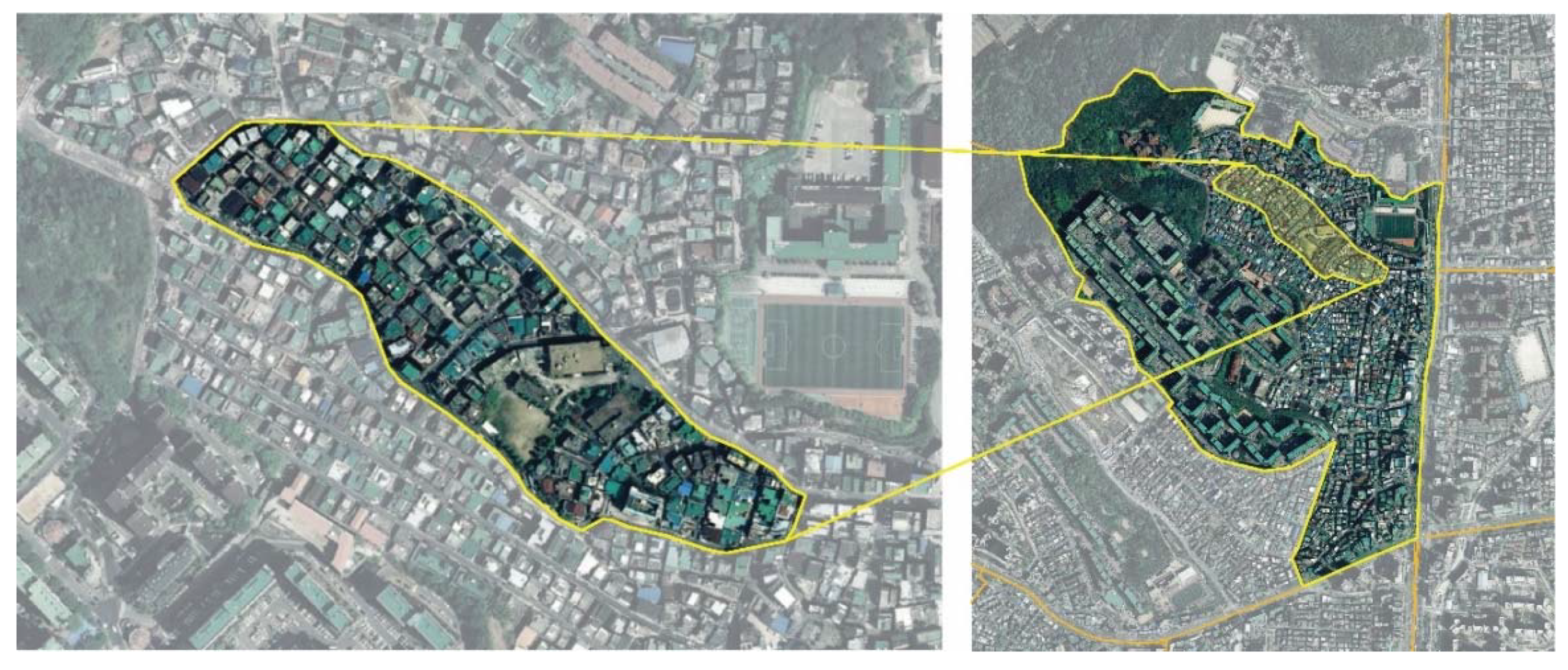
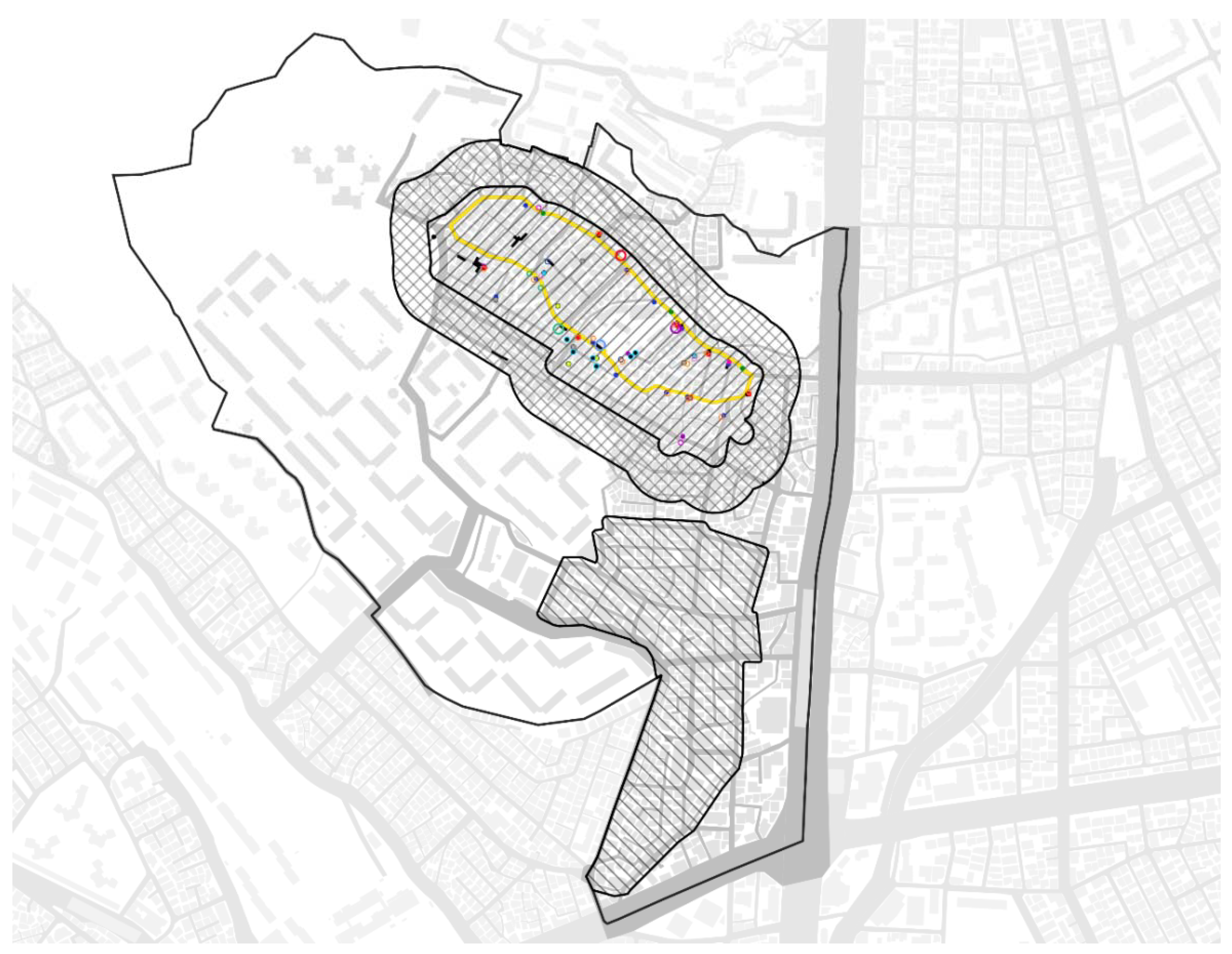
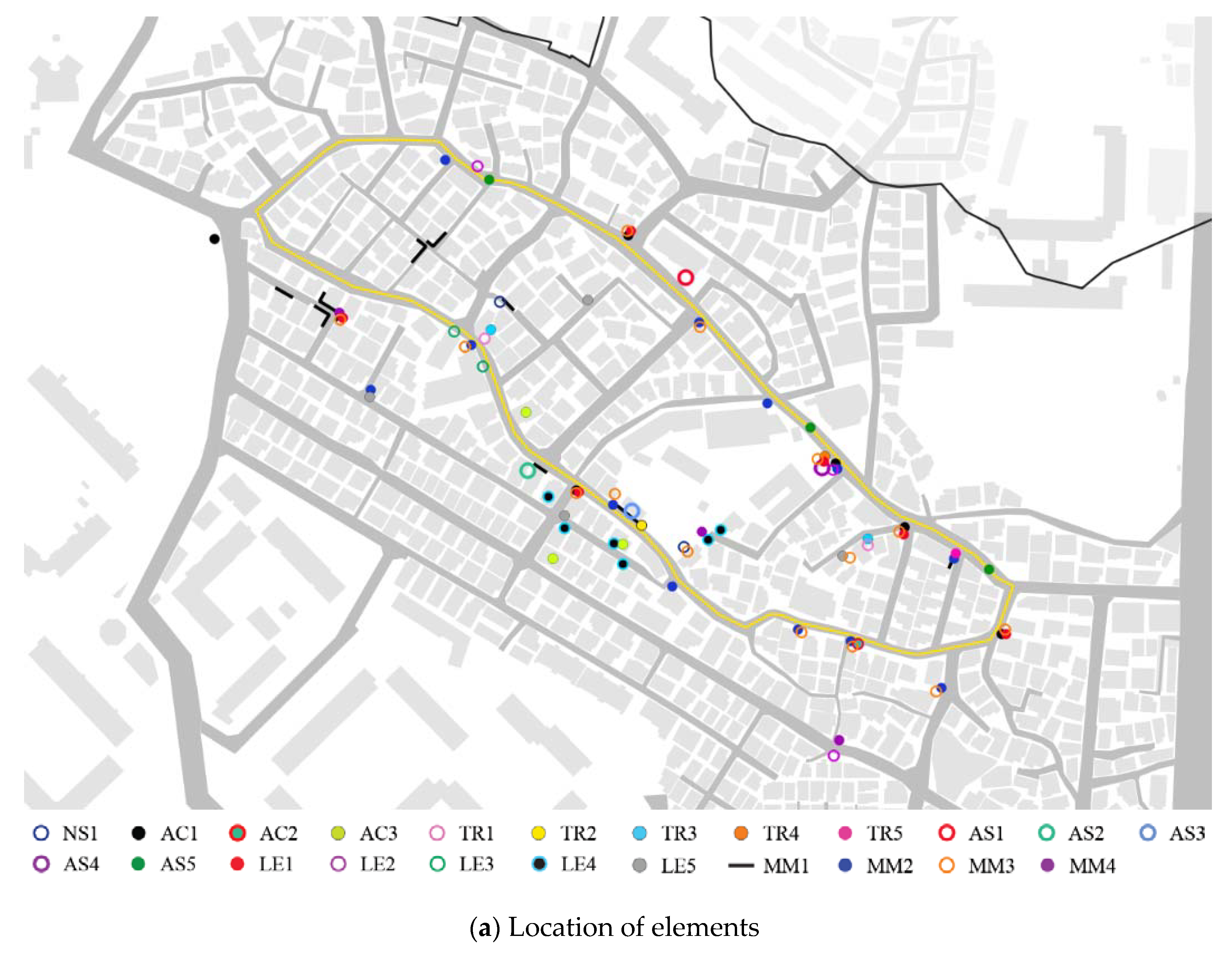
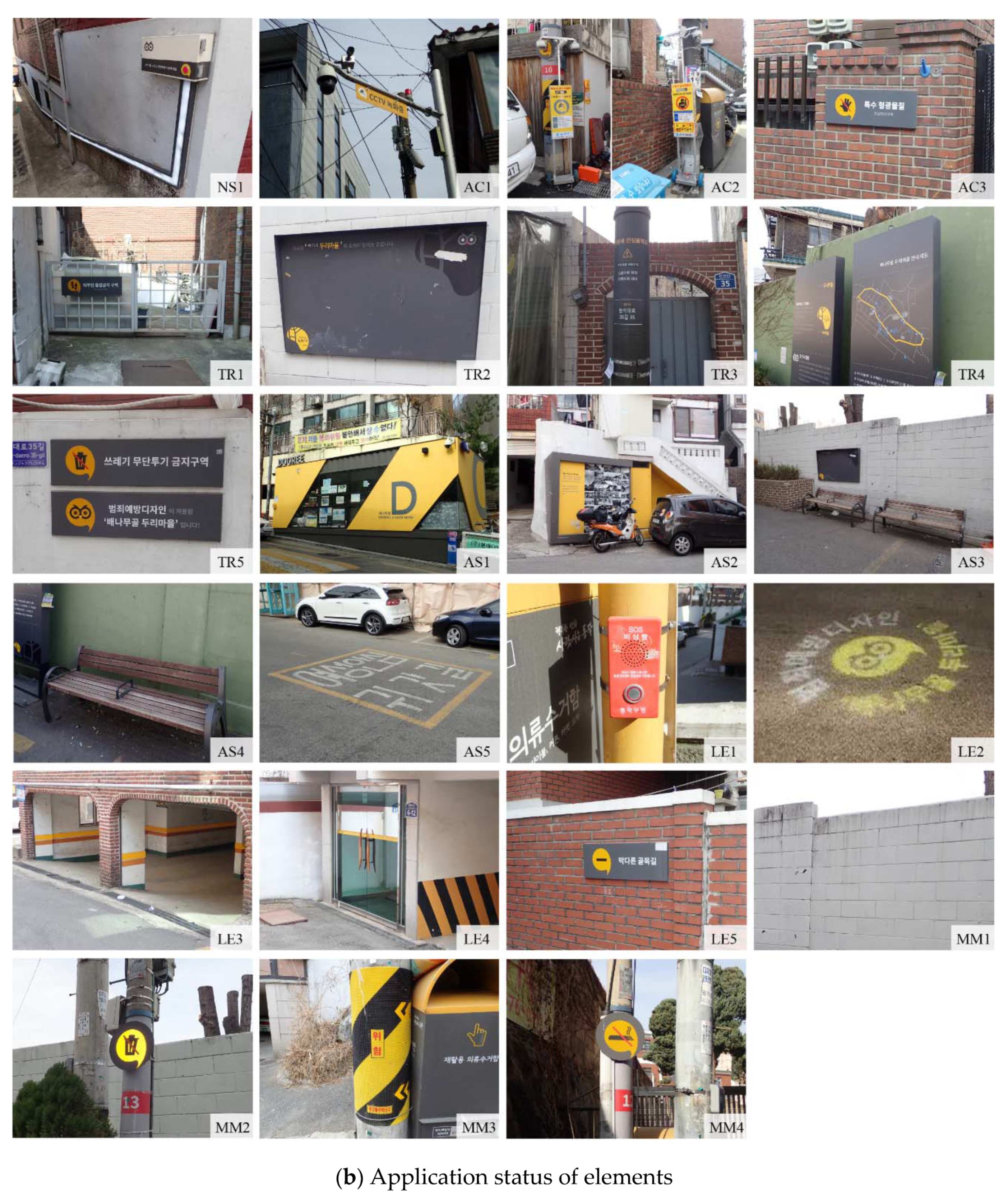

| Category | Crime Prevention Design Implementation Elements | ||
|---|---|---|---|
| Natural Surveillance | Security Lighting |  | NS1 |
| Access Control | CCTV and Recording Sign |  | AC1 |
| Mobile CCTV |  | AC2 | |
| Fluorescent invisible detection paste and notice sign |  | AC3 | |
| Territoriality | Territoriality reinforcement security door |  | TR1 |
| Territoriality reinforcement town notice board |  | TR2 | |
| Territoriality reinforcement guide sign |  | TR3 | |
| Guide map and Crime prevention design project notice |  | TR4 | |
| Crime prevention design area sign |  | TR5 | |
| Activity Support | Duri Jikim Maru (Community Center) |  | AS1 |
| Fence of memories (Fence board) |  | AS2 | |
| Doori meeting place |  | AS3 | |
| Doori Shelter |  | AS4 | |
| Pavement marking “safe road for women” |  | AS5 | |
| Legibility | Emergency bell |  | LE1 |
| Gobo lighting |  | LE2 | |
| Retroreflective sheet |  | LE3 | |
| Mirror sheet |  | LE4 | |
| Cul-de-sac sign |  | LE5 | |
| Maintenance and Management | Fence painting |  | MM1 |
| No littering sign |  | MM2 | |
| Illegal attachment prevention sheet |  | MM3 | |
| No smoking sign |  | MM4 | |
| Category | Results | Interpretation |
|---|---|---|
| Success Measure | (3) > 0 | Failure of the crime prevention strategy |
| (3) < 0 | Success of the crime prevention strategy | |
| Buffer Displacement Measure | (4) > 0 | Crime displacement effect expected |
| (4) < 0 | Diffusion effect of crime control benefits expected |
| WDQ Value | Interpretation | |
|---|---|---|
| WDQ > 1 | Diffusion of control benefits > direct effect > crime displacement | With a considerable positive effect |
| WDQ ≒ 1 | Diffusion of control benefits ≒ direct effect > crime displacement | With the same effect on the buffer zone as in the target area |
| 1 > WDQ > 0 | Direct effect > diffusion of control benefits > crime displacement | With a positive effect on the buffer zone as well |
| WDQ = 0 | Crime displacement ≒ 0 and diffusion of control benefits ≒ 0 or crime displacement ≒ diffusion of control benefits | Trade-off predicted; additional test on crime rate fluctuation over the target area required |
| 0 > WDQ > −1 | Direct effect > crime displacement > diffusion of control benefits | Crime rate decrease over the target area; crime displacement over the buffer zone |
| WDQ ≒ −1 | Crime displacement ≒ direct effect > diffusion of control benefits | No effect of the crime prevention strategy |
| −1 > WDQ | Crime displacement > direct effect > diffusion of control benefits | Deterioration after crime prevention strategy implementation |
| Category | 1 January 2014–31 December 2014 | 1 January 2017–31 December 2017 |
|---|---|---|
| Burglary | 116 | 145 |
| Violence | 144 | 207 |
| Rape | 7 | 15 |
| Robbery | 1 | 0 |
| Murder | 0 | 0 |
| Total | 268 | 367 |
| Category | Pre-Implementation 1 | Post-Implementation 2 | ||
|---|---|---|---|---|
| Crime Count | Per 100,000 | Crime Count | Per 100,000 | |
| Burglary | ||||
| Target area | 9 | 29 | 11 | 39 |
| Comparison area | 39 | 128 | 58 | 205 |
| Buffer zone | 14 | 46 | 10 | 35 |
| Violence | ||||
| Target area | 13 | 43 | 9 | 32 |
| Comparison area | 50 | 163 | 92 | 324 |
| Buffer zone | 8 | 26 | 12 | 42 |
| Category | Pre | Post | No. of Changes | Change Rate | NE |
|---|---|---|---|---|---|
| Burglary | |||||
| Target area | 29 | 39 | −10 | 34.48 | 0.04 |
| Comparison area | 128 | 205 | −77 | 60.16 | |
| Buffer zone | 46 | 35 | 11 | −23.91 | |
| Violence | |||||
| Target area | 43 | 32 | 11 | −25.58 | 0.17 |
| Comparison area | 163 | 324 | −161 | 98.77 | |
| Buffer zone | 26 | 42 | −16 | 61.54 |
| Category | Pre | Post | WDQ | TNE |
|---|---|---|---|---|
| Burglary | ||||
| Target area | 29 | 39 | 5.19 | 46.12 |
| Comparison area | 128 | 205 | ||
| Buffer zone | 46 | 35 | ||
| Violence | ||||
| Target area | 43 | 32 | 0.18 | 63.15 |
| Comparison area | 163 | 324 | ||
| Buffer zone | 26 | 42 |
© 2019 by the authors. Licensee MDPI, Basel, Switzerland. This article is an open access article distributed under the terms and conditions of the Creative Commons Attribution (CC BY) license (http://creativecommons.org/licenses/by/4.0/).
Share and Cite
Kim, D.; Hong, S.-W.; Jeong, Y. Crime Prevention Effect of the Second Generation Crime Prevention through Environmental Design Project in South Korea: An Analysis. Soc. Sci. 2019, 8, 187. https://doi.org/10.3390/socsci8060187
Kim D, Hong S-W, Jeong Y. Crime Prevention Effect of the Second Generation Crime Prevention through Environmental Design Project in South Korea: An Analysis. Social Sciences. 2019; 8(6):187. https://doi.org/10.3390/socsci8060187
Chicago/Turabian StyleKim, Dahee, Seung-Wan Hong, and Yongwook Jeong. 2019. "Crime Prevention Effect of the Second Generation Crime Prevention through Environmental Design Project in South Korea: An Analysis" Social Sciences 8, no. 6: 187. https://doi.org/10.3390/socsci8060187
APA StyleKim, D., Hong, S.-W., & Jeong, Y. (2019). Crime Prevention Effect of the Second Generation Crime Prevention through Environmental Design Project in South Korea: An Analysis. Social Sciences, 8(6), 187. https://doi.org/10.3390/socsci8060187





